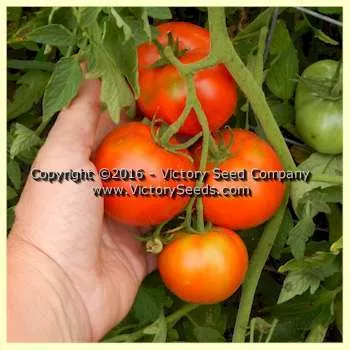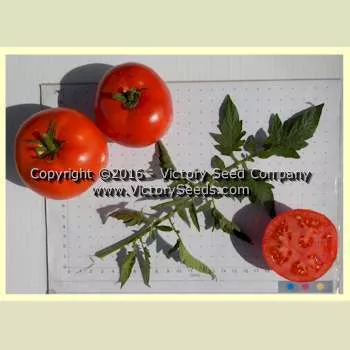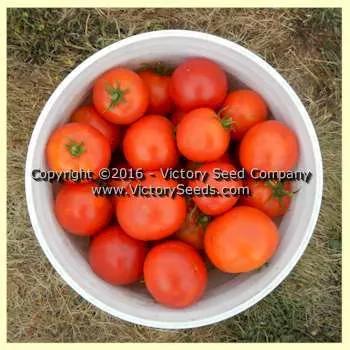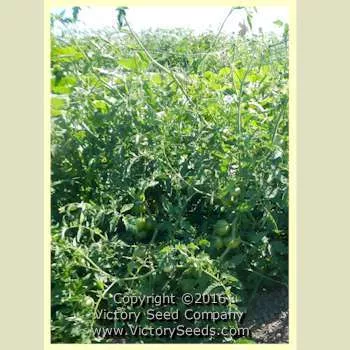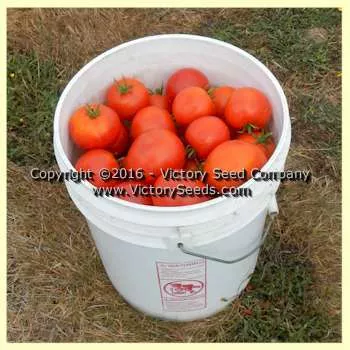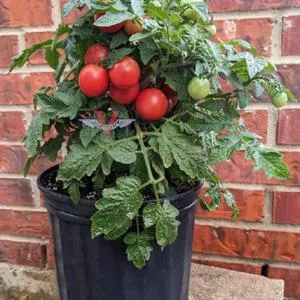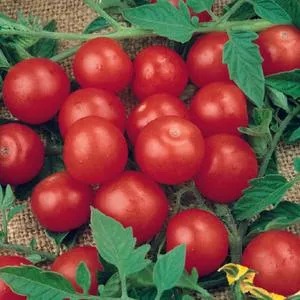






Break O' Day Tomato
Solanum lycopersicum
Price: $3.45
SKU: 340366185 days, indeterminate - 'Break O' Day' produces small-leaved, open, spreading vines well supported by an extensive root system. The red fruit are large, smooth, meaty, and globular, similar to those of the 'Marglobe'.
'Break O' Day' is resistant to Fusarium wilt of vines and to nailhead rust of fruit. It is also slightly resistant to several blights, especially Septoria leaf spot and early blight. Moreover, it seems to be fully as resistant to blossom-end rot as the 'Marglobe'. In many fields, 'Break O' Day' and 'Marglobe' were practically free from blossom-end rot, while other varieties growing beside them were badly affected by it. 'Break O' Day' also possesses some resistance to drought and other adverse weather conditions.[1]
In their 1931 seed catalog, F. W. Bolgiano & Company stated:
'Break O' Day' is resistant to Fusarium wilt of vines and to nailhead rust of fruit. It is also slightly resistant to several blights, especially Septoria leaf spot and early blight. Moreover, it seems to be fully as resistant to blossom-end rot as the 'Marglobe'. In many fields, 'Break O' Day' and 'Marglobe' were practically free from blossom-end rot, while other varieties growing beside them were badly affected by it. 'Break O' Day' also possesses some resistance to drought and other adverse weather conditions.[1]
In their 1931 seed catalog, F. W. Bolgiano & Company stated:
"It holds well during the hot weather and is an abundant yielder throughout the entire season. No acid, just full of deliciously sweet, beautiful red meat. We can highly recommend Break O' Day to market gardeners, kitchen gardeners and canners."
W. Atlee Burpee's 1932 seed catalog describes it as follows:"Beautiful scarlet tomatoes of medium size; deep, solid, and almost seedless. Of vigorous growth, but with relatively sparse foliage. It matures 10 days to 2 weeks earlier than Marvel. From present indications it will be the most popular early Tomato in the market gardening and trucking districts."
Dr. Carolyn Male describes it as being as productive as modern hybrids.[4] 'Break O' Day' originated from a cross between the 'Marglobe' and 'Marvana' made at the USDA's greenhouses in Washington, D.C. in 1923 and was introduced commercially in 1931. Our stock was grown out from USDA accession number PI 270174.
Fruit Color: Red
Special Groups: "Epic" Tomatoes
Harvest Timing: Late Season
Genetic Classification: Open Pollinated
Special Groups: "Epic" Tomatoes
Harvest Timing: Late Season
Genetic Classification: Open Pollinated
Sow seeds indoors (do not direct sow into the garden), using sterile seed starting mix, 6 to 8 weeks before your last expected frost date. Plant 1/4" deep, water lightly but keep moist until emergence.
Full light and cooler temps (60° to 70°) will help to prevent the seedlings from becoming too leggy. If plants become rootbound before you can safely set them into the ground, transplant them into larger pots.
Harden off plants before planting outside. Young plants are very susceptible to frost and sunburn damage. Avoid too much nitrogen. Water evenly but not in excess.
Click here to view our full tomato growing guide.
Full light and cooler temps (60° to 70°) will help to prevent the seedlings from becoming too leggy. If plants become rootbound before you can safely set them into the ground, transplant them into larger pots.
Harden off plants before planting outside. Young plants are very susceptible to frost and sunburn damage. Avoid too much nitrogen. Water evenly but not in excess.
Click here to view our full tomato growing guide.
Informational References:
- "The Break O' Day Tomato," by Fred J. Pritchard and William S. Porte, USDA, Circular No. 218, March, 1932.
- "Yearbook of Agriculture," USDA, 1937
- "Tomato Varieties," by Gordon Morrison, Michigan State College A.E.S., Special Bulletin 290, April 1938
- "100 Heirloom Tomatoes for the American Garden," Dr. Carolyn Male, Workman Publishing, 1999, pages 74-75.
Customer Reviews:
Do you have experience with this one? 📝 📣 Write a review!
No reviews have been posted yet.

